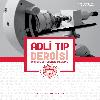ARI SOKMASINA BAĞLI İKİ ÖLÜM OLGUSU
EVALUATION OF TWO DEATH CASES DUE
___
- 1. Kalpaklıoğlu AF. Böcek allerjisi. Asthma Allergy Immunol. 2003; 1(1): 44-53
- 2. Golden DBK. Allergic reactions to insect stings. In: Bierman CW, Pearlman DS, Shapiro GG, Busse WW (eds). Allergy Asthma an Immunology from Infancy to Adulthood. Philadelphia: WB. Saunders Comp. 1996: 348-54.
- 3. Yunginger JW. Insect allergy. In: Middleton E, Reed CE, Ellis EF, Adkinson NF, Junginger JW, Busse WW (eds). Allergy Principles and Practice. St. Louis: Mosby, 1993: 1511-24.
- 4. Schwartz HJ, Sutheimer C, Gauerke MB. Venom- specific IgE in postmortem sera from victims of sudden, unexpected death. J Allergy Clin Immunol. 1984; 73: 189-93.
- 5. Müller UR. Hymenoptera venom hypersensitivity: An update. Clin Exp Allergy. 1998; 28: 4-6.
- 6. Kalyoncu AF. Honey allergy in Ankara. Allergy 1997; 52: 876-7.
- 7. Kalyoncu AF, Demir AU, Özcan Ü ve ark. Bee and wasp venom allergy in Turkey. Ann Allergy Asthma Immunol 1997; 78: 408-12.
- 8. Kalyoncu AF. The prevalence of Hymenoptera stings in primary school children in Ankara. Int Rev Allergol Clin Immunol 1998; 4: 136-8.
- 9. Incorvaia C, Pucci S, Pastorello EA. Clinical as- pects of Hymenoptera venom allergy. Allergy 1999; 54(Suppl 58): 50-2.
- 10. Şener S, Yaylacı S. 2010 Kardiyopulmoner resusitasyon ve acil kardiyovasküler bakım klavuzu “İki klavuz ve günlük pratiğimizdeki önemli değişiklikler. Turk J Emerg Med. 2010; 10(4): 199-208.
- 11. Johansson B, Eriksson A, Örnehult L. Human fatalities caused by wasp and bee stings in Sweden. Int J Leg Med. 1991; 104: 99-103.
- 12. Prado M, Quiros D, Lomonte B. Mortality due to Hymenoptera stings in Costa Rica, 1985-2006. Pan Am J Public Health. 2009; 25(5): 389-93.
- 13. Langley RL. Animal related fatalities in the United States-an update. Wildern Environ Med. 2005; 16: 67–74.
- 14. Riches KJ, Gillis D, James R. An autopsy approach to bee sting-related deaths. Pathology. 2002; 34: 257-62.
- 15. Harvey P, Sperber S, Kette F, Heddle RJ, Roberts-Thomson PJ. Bee-sting mortality in Australia. Med J Aust. 1984; 140: 209–11.
- 16. Mosbech H. Death caused by wasp and bee stings in Denmark 1960–1980. Allergy. 1983; 38: 195–200.
- 17. Rubenstein HS. Bee-sting diseases: Who is at risk? What is the treatment? Lancet. 1982; 1(8270): 496–9.
- 18. Barnard JH. Studies of 400 Hymenoptera sting deaths in the United States. J Allergy Clin Immunol. 1973; 52: 259-264.
- 19. Janssen W. Plötzliche Todesfölle durch Insektenstiche. Morphologie, Toxikologie und forensische Bedeutung. Dtsch Z Gerichtl Med. 1966; 58: 3-17.
- 20. Delage C, lrey NS. Anaphylactic deaths: a clinicopathologic study of 43 cases. J Forensic Sci. 1972; 17: 525-540.
- 21. Şimşek M, Seyfikli Z, Akkurt İ, Abadoğlu Ö. Sivas ili Zara ilçesinde arı allerjisi prevalansı. T Klin Allerji Astım. 2000; 2: 127-32
- ISSN: 1018-5275
- Başlangıç: 1985
- Yayıncı: BAYT Yayıncılık
ERZURUM’DA 2008-2009 YILLARI ARASINDAKİ MEDİKOLEGAL ÖLÜMLERİN DEĞERLENDİRİLMESİ
Muhammed Ziya KIR, Hüseyin Çetin KETENCİ, Ahmet Ziver BAŞBULUT
ÇOCUK YOĞUN BAKIM ÜNİTESİNDE TAKİP EDİLEN SUDA BOĞULMA VE BOĞULAYAZMA OLGULARI
Mehmet BOŞNAK, Gülseren BİLEN, Murat TUTANÇ, Ali KARAKUŞ, Cem ZEREN
YILDIRIM ÇARPMASINA BAĞLI KAFATASI KIRIĞI; BİR ÖLÜM OLGUSU
Sait ÖZSOY, Mükerrem SAFALI, Harun TUĞCU, Mehmet TOYGAR
OLFAKTÖR SİNİR YARALANMASI: BİR OLGU SUNUMU
M Mustafa ARSLAN, Ramazan KARANFİL, Yaşar ÇOKKESER, Cem ZEREN
KAHRAMANMARAŞ SÜTÇÜ İMAM ÜNİVERSİTESİ TIP FAKÜLTESİ ADLİ TIP ANABİLİM DALINA 2009-2010 YILLARINDA
ARI SOKMASINA BAĞLI İKİ ÖLÜM OLGUSU
Muhammed Ziya KIR, Hüseyin Çetin KETENCİ, Ahmet Ziver BAŞBULUT, Mücahit EMET, Mustafa UZKESER
KALP TAMPONADI: İSTANBUL’DA HEMOPERİKARDİUM KAYNAKLI ÖLÜMLER
Yavuz HEKİMOĞLU, A Sadi ÇAĞDIR, A Selçuk GÜRLER, D Oğuzhan MELEZ, Yalçın BÜYÜK
